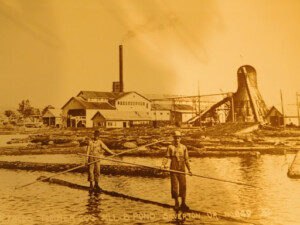The Lumber Industry
You might say that lumber was Salem’s first industry going back all the way to July 1840 when the Methodist missionaries built a saw and grist mill on North Mill Creek near Broadway & High Streets. A historic marker marks the site. Lumber for Salem’s first house, the Jason Lee house built in 1841 and now located at Mission Mill, was cut at that primitive sawmill. In 1858 B.M. Durelle a later pioneer, purchased a steamboat and started a floating sawmill, but shortly after moved his machinery to a plant on the river bank just north side of Trade Street. Fire struck his plant in 1860 and the larger plant he built was washed away in the floods of 1861.

Black and white photograph showing two men balancing on log with polls (pikes) in a log pond. Behind is a mill, with tall stack and various buildings and chains. Wig wam burner to right of image. Title written on bottom with DB monogram., WHC Collections EX 2019.003.0010
In 1866 the Capital Lumbering Company was organized and built at Durelle’s site on the river between Trade & Ferry Streets and remained the principal sawmill in the Salem area for many decades.
The Oregon Pulp & Paper Company began production at the same site in 1920 and also owned half of the Charles K. Spaulding Logging Company, an adjoining sawmill to the north. The gabled roof of the Oregon Pulp & Paper Company building can still be seen as being a part of the Boise Cascade plant. In 1949 Oregon Pulp & Paper was the largest Salem employer, with 600 employees, except for the State. The plant’s papers were distributed as far east as Chicago, and to Mexico, South America, Asia, Africa and the Pacific islands. The sawmill was closed in June 1955, eliminating 135 jobs, and leaving 465 at the paper mill.
Boise Cascade purchased Oregon Pulp & Paper in 1962 and a yeast plant was added to convert byproducts of papermaking into a food additive. In 1964 a container plant was added to supply cartons for food processing plants. Several improvements were made under Boise both to expand production and to meet air and water quality standards; purification lagoons were built on Minto-Brown Island across the slough.
The Spaulding Logging Company got their logs primarily from the tributaries of the Willamette and were sometimes brought overland and dumped into the river to be towed down. Others were brought in by two steamboats which the company owned, the “City of Eugene” and “Grey Eagle”. Other departments planed and finished the wood; a large box factory supplied local companies with shipping crates & boxes; and a sash & door factory equipped with machines for turning and finishing cabinets, chairs, staircases, and other furniture. In addition to Oregon lumber, more exotic woods were also finished for windows, doors. In 1949 the Spaulding Company, as the lumber division of Oregon Pulp & Paper was shipping between 1200 and 1300 carloads of lumber annually to practically every state in the country.
The preceding were not by any means the only sawmills in the Salem area. E.D. Towl had the “Clipper Saw Mill” four miles north of Salem in 1865, and many smaller businesses were also allied with the lumber industry. The 1890 Sanborn-Perris Map shows the following: Churchill Sash, Door & Manufacturing Company, the Erb Sash & Door Factory, T. Holman Fanning Mill, J.F. Jacobson Lumber Yard & Western Fanning Mill. All were within a couple blocks of the lumbering company. However, within three years related businesses were being located further out at 12th & Trade (J.C. Goodale), 12th & Bellevue (Santiam Lumbering), and Saginaw & Wilson (South Salem Planing Mill).
Researched and written by Joan Marie “Toni” Meyering
Bibliography:
“Site of Paper Mill Played Big Role in Salem History” by Walt Penk, Statesman Journal, 1981+
“The Chas. K. Spaulding Logging Company”, Oregon Statesman, January 1, 1914.
“Oregon Pulp and Paper Biggest Except State Gov’t”, Capital Journal, January 28, 1949.
“Clipper Saw Mill”, Oregon Statesman, April 17, 1865.
“Salem Lumber Firm Closing in May”, Statesman Journal, December 19, 1991.
This article originally appeared on the original Salem Online History site and has not been updated since 2006.







Leave A Comment